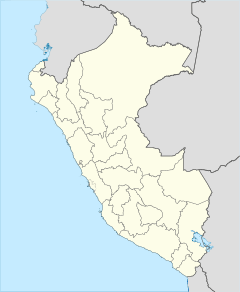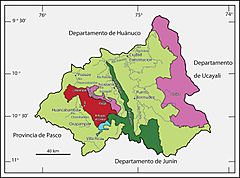San Matías–San Carlos Protection Forest facts for kids
Quick facts for kids San Matías–San Carlos Protection Forest |
|
|---|---|
| Bosque de Protección San Matías-San Carlos | |
|
IUCN Category VI (Managed Resource Protected Area)
|
|
| Location | Pasco Region, Peru |
| Area | 1,458 km2 (563 sq mi) |
| Established | 1987 |
The San Matías–San Carlos Protection Forest (also known as Bosque de Protección San Matías-San Carlos) is a special natural area in the Pasco Region of Peru. It's like a guardian for the land. This forest helps protect the soil and keeps towns, buildings, and farms safe. It stops things like soil washing away (erosion), mudslides (huaycos), and floods from streams.
This important forest is found within two types of forest areas: the Peruvian Yungas and the Ucayali moist forests. It also helps protect the culture and traditions of local communities, like the Ashaninka and Amuesha people, who live there.
Contents
What is a Protection Forest?
A protection forest is a specific type of protected area. It is set aside by the government to keep natural processes stable. This means it helps prevent natural disasters. It also makes sure that water sources stay clean and healthy for everyone.
Why San Matías–San Carlos is Important
The San Matías–San Carlos Protection Forest plays a big role in its region. It protects the land from damage caused by heavy rains and rivers. This helps keep the soil rich for farming. It also protects homes and roads from natural disasters.
Protecting Local Communities
This forest is also vital for the people who live nearby. It helps keep the traditions and ways of life of the Ashaninka and Amuesha communities safe. These communities have lived in harmony with the forest for a very long time.
Where is the Forest Located?
The San Matías–San Carlos Protection Forest is located in the central part of Peru. It is in the Pasco Region, which is known for its beautiful natural landscapes. The forest covers a large area of about 1,458 square kilometers (563 square miles). It was officially established in 1987.
See also
 In Spanish: Bosque de protección de San Matías-San Carlos para niños
In Spanish: Bosque de protección de San Matías-San Carlos para niños



